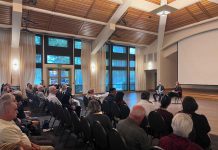BY ROCKE GARCIA
My wife and I have been homebuilders in Morgan Hill for the past 25 years and have an intimate knowledge of the Residential Development Control System (Morgan Hill’s growth control Measure C) and the below market rate (BMR) housing program. I have been on the General Plan committee, the Urban Limit Line committee, the RDCS committee and various downtown improvement committees.
The BMR issue is not as simple as the Morgan Hill Times Dec. 11 editorial stated.
Arguing that the current city allocation of affordable housing units is sound and meets the needs of a diverse community misstates the facts of the issue. We all believe in affordable housing, but how does the city equitably address the BMR issue?
Presently the city has estimated that 38 percent of the new housing to be built over the next five years is for “subsidized/affordable” including BMR housing. That’s too much. It is not sound economic practice and in the end will not foster housing diversity.
The General Plan anticipates that, as a balanced community, we should have 70 percent single-family detached homes and 30 percent attached homes. In meeting these goals, it’s important to also balance our BMR housing. In my opinion, no more than 20 percent of all our new homes should be “restricted/subsidized” including BMR homes. The RDA and the non-profit housing developers should build 10 percent, and the for-profit builders 10 percent, totaling the 20 percent. These homes should be proportionately distributed per the General Plan.
Will 20 percent of the new homes in Morgan Hill built as BMR homes be economically sound and meet the needs of a diverse community?
Yes, I think so. That 20 percent goal is significantly better than any other community in Santa Clara Valley. I would also suggest that resale restrictions set by the city on BMR homes be revisited. Let’s give those buyers/potential sellers, who need a chance to move up to a market-rate home in the future, the incentive to do so, and allow another deserving family to purchase an income-restricted home. Presently there is no incentive for BMR owners to upgrade.
Your statement that the city’s BMR pricing guidelines are in accordance with the Association of Bay Area Governments and the Department of Housing and Urban Development is not true.
Our development agreements for all of our recent subdivisions include the following requirements for low-income BMR homes:
a. Consider family size but no distinction shall be made between adults and children.
b. BMR homes must be affordable to families at or below the county’s median income per HUD.
c. Monthly housing cost shall include:
- Unit purchase price
-
Current lending rates
-
Estimated property taxes, insurance, Homeowners Association dues
-
Other expense as determined by the lender
d. BMR homes must be available to first time homebuyers who live in the he county
e. Resale restriction for 45 years
f. The city selects the buyer
We are building three- and four-bedroom homes which qualify for the low BMR program. These homes are single-family detached homes, one- and two-story, with two- or two-and-one-half baths. They range from 1,217 square feet to 1,515 square feet. In Morgan Hill and Jose’s Blossom Valley, single-family detached homes with similar square footages have sold in excess of $600,000.
The HUD limits for median income for Santa Clara County varies by family size: family of four – $84,000, to a family of eight -$112,050. The Santa Clara Housing Authority requires three- and four-bedroom units to be occupied by five or more family members. The city has set the maximum qualifying income for the city’s BMR low at $84,900. The city by setting this maximum qualifying annual income has effectively disqualified potential BMR buyers whose family income is above $84,900 and below $112,050. This is the crux of the issue.
The city’s own documents reveal that the average annual income of Morgan Hill’s low BMR buyer is below $50,000 with some BMR buyers with income as low as $12,000 per year. Income of $50,000 qualifies for a very low BMR home program, not a low BMR home.
The RDCS (Measure C) allows homebuilders to select low and very low income levels for their BMR commitment. In our case we selected the low income level. We also selected a four-bedroom detached home of 1,515 square feet. The price of the low BMR homes should be comparable to similar BMR homes in San Jose and Gilroy.
So why does all this matter? The city fixed the low BMR home pricing to the very low income criteria. This was done by artificially restricting income ratios, limiting annual income, not requiring down payments, and using higher than normal interest rates. Yes, my method will mean that a very low income buyer would not be able to purchase a new four-bedroom single-family detached home in our project. The low income BMR should be reasonably priced in the mid $300,000 range. This sales price would be similar to Gilroy. Buyers would be still purchasing a new home for about 50 percent of true value.
What is my solution? The private marketplace should determine the price of a BMR within the approved guidelines. A single-family detached home would most likely be priced higher than a townhouse or condominium. Location could also matter. Overall the Morgan Hill BMR housing prices should not be unrealistically above or below a similar product in our neighboring communities as they are now.
Income qualification is the critical issue for BMR home ownership as it is for any home purchase. And yes, the city should have the responsibility to verify income and that income be “at or below county median income” so that we are all assured that qualified buyers are purchasing these new BMR homes.
Yes, I’m a homebuilder and I do believe in social responsibility. However, I believe that social responsibility is a personal issue. I am sure that there must be 10,000 families in the valley who would qualify under some subsidized housing program. I would like to build homes for all of them but I cannot, financially or otherwise.
I respect and expect fairness, especially with regards to this issue of the BMR housing standards and program. The current BMR standards, as interpreted by the city, are flawed and have nothing to do with social responsibility.







